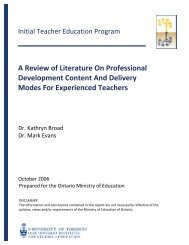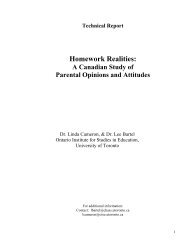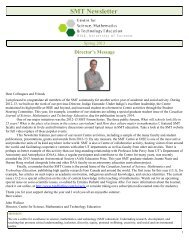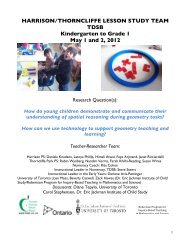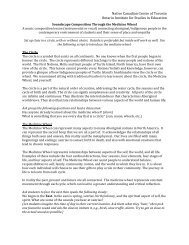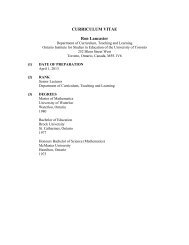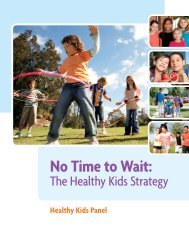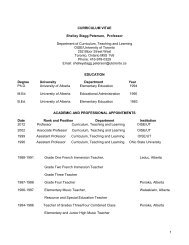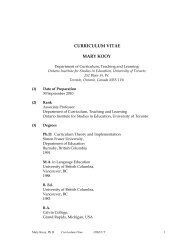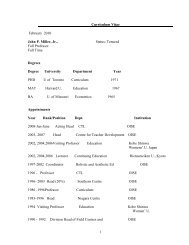The Ontario Curriculum, Grades 9-12 - Ministère de l'éducation ...
The Ontario Curriculum, Grades 9-12 - Ministère de l'éducation ...
The Ontario Curriculum, Grades 9-12 - Ministère de l'éducation ...
You also want an ePaper? Increase the reach of your titles
YUMPU automatically turns print PDFs into web optimized ePapers that Google loves.
C3. Un<strong>de</strong>rstanding Basic Concepts<br />
C3. <strong>de</strong>monstrate an un<strong>de</strong>rstanding of various environmental factors that can affect human<br />
health, and explain how the impact of these factors can be reduced<br />
C3.1 i<strong>de</strong>ntify the main pollutants and environmental contaminants that can affect human health<br />
(e.g., air pollutants such as sulfur dioxi<strong>de</strong>, nitrous oxi<strong>de</strong>, and particulates; noise pollution;<br />
heavy metals such as lead and mercury; DDT; PCBs; mould; volatile organic compounds<br />
such as acetone and chlorinated solvents)<br />
C3.2 <strong>de</strong>scribe the effects of a variety of environmental factors on human health (e.g., air<br />
pollutants are associated with disor<strong>de</strong>rs such as asthma; consumption of fish products<br />
from contaminated water may lead to increased levels of heavy metals in the human<br />
body; the thinning of the ozone layer may lead to increased inci<strong>de</strong>nce of skin cancer;<br />
noise pollution may impair hearing)<br />
C3.3 <strong>de</strong>scribe ways in which a variety of environmental contaminants (e.g., volatile organic<br />
compounds in paints, carpets, and cleaning products; mercury in fish; E. coli in the water<br />
at public beaches) can enter the human body (e.g., inhalation, ingestion, absorption)<br />
C3.4 <strong>de</strong>scribe measures that can reduce exposure to environmental contaminants (e.g., wearing<br />
protective clothing or sunscreen, or remaining indoors during peak UV hours, to prevent<br />
exposure to ultraviolet rays; avoiding the use of paints, solvents, and cleaning agents that<br />
contain volatile organic compounds)<br />
C3.5 i<strong>de</strong>ntify a variety of populations who are particularly vulnerable to the effects of<br />
environmental factors, and explain why these populations are vulnerable (e.g., seniors are<br />
vulnerable to extreme temperatures because the ability to regulate body temperature<br />
diminishes as people age; Inuit who follow a traditional diet are vulnerable to<br />
contaminants that accumulate in the fatty tissue of sea mammals because these animals<br />
are their main food source)<br />
D. Sustainable Agriculture and Forestry<br />
D1. Relating Science to Technology, Society, and the Environment<br />
D1. evaluate the impact of agricultural and forestry practices on human health, the economy,<br />
and the environment<br />
D1.1 evaluate, on the basis of research, a variety of agricultural and forestry practices (e.g.,<br />
companion planting, biological pest control, the use of genetically modified seed, forest<br />
fire control) with respect to their impact on the economy and the environment (e.g., the<br />
use of nemato<strong>de</strong>s eliminates crop damage from grubs, thus contributing to better harvests,<br />
while reducing the use of toxic chemical pestici<strong>de</strong>s; un<strong>de</strong>r some circumstances, forest<br />
thinning can help prevent or reduce the seriousness of forest fire, and its economic and<br />
environmental consequences) [IP, PR, AI, C]<br />
Sample issue: <strong>The</strong> recycling of animal waste as fertilizer is economical and is generally<br />
consi<strong>de</strong>red an environmentally sustainable practice. However, care must be taken that the<br />
manure does not run off into water sources, as it can contaminate them with E. coli and<br />
other bacteria.<br />
Sample questions: What are the economic and environmental pros and cons of growing<br />
crops that are genetically modified to be herbici<strong>de</strong> resistant? Why is organic produce<br />
more expensive than conventionally grown produce? What are the economic advantages<br />
134 Environmental Education, <strong>Gra<strong>de</strong>s</strong> 9−<strong>12</strong>: Scope and Sequence of Expectations, 2011



